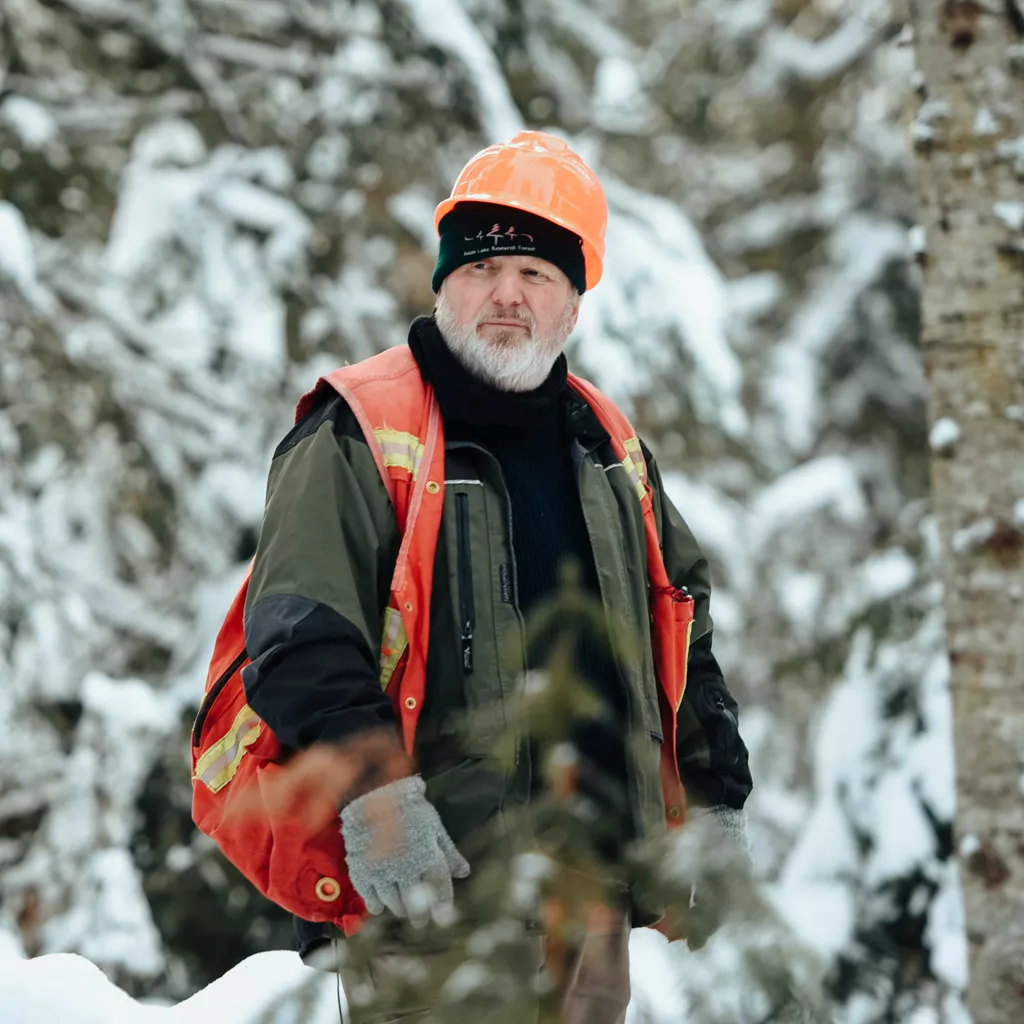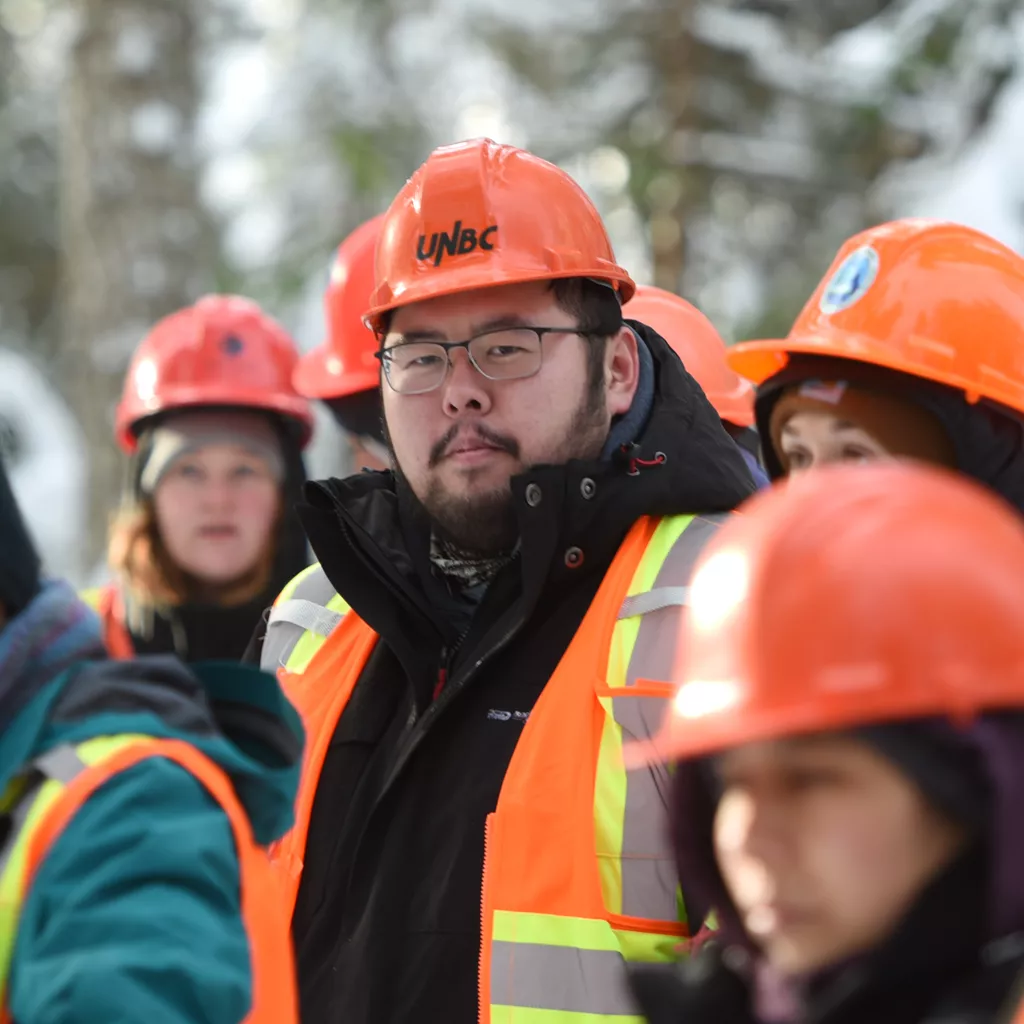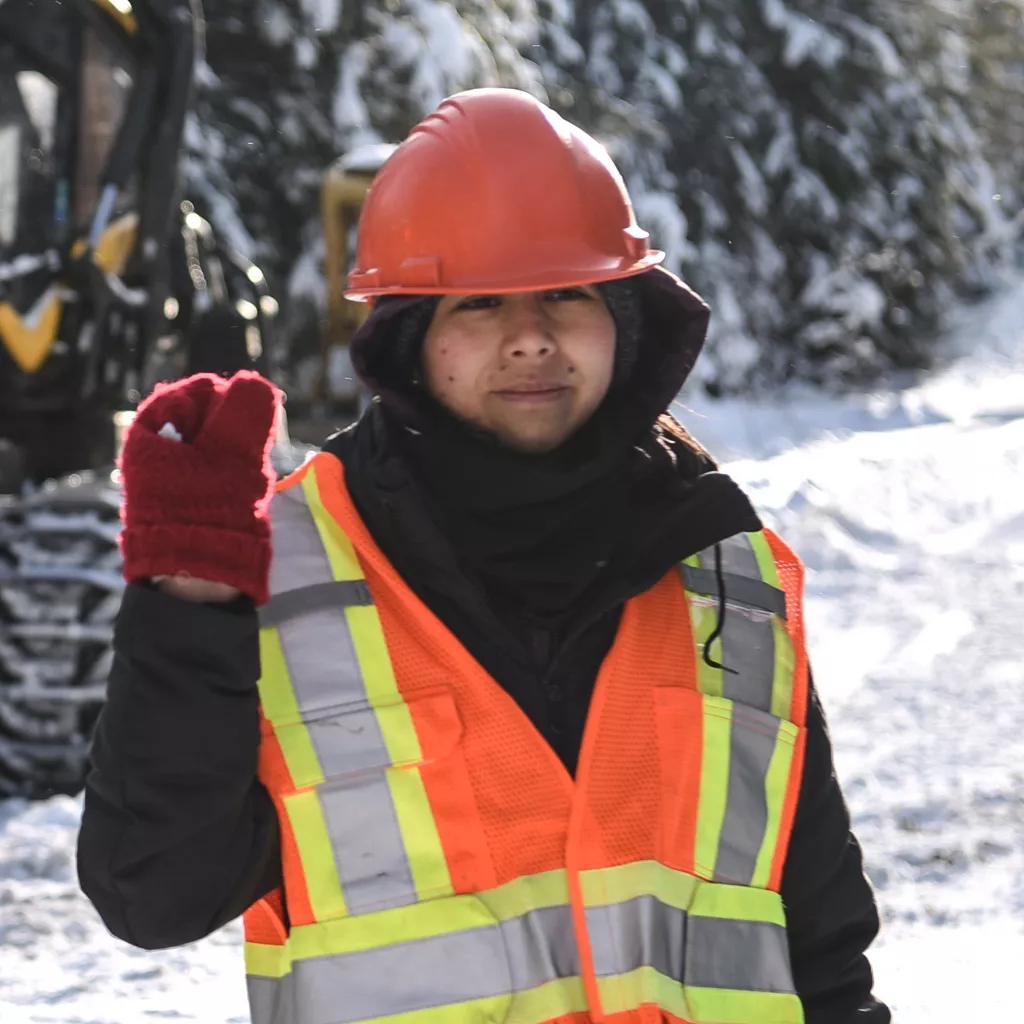Harvesting sustainable solutions
A recent guided tour of the Aleza Lake Research Forest provided students with a rare opportunity to see working examples of a harvesting techniques that offer new approaches to sustainable forest management.

A bright, cold winter day provided the perfect backdrop for an indelible learning opportunity for a group of students from UNBC and the College of New Caledonia to see first-hand a unique timber harvesting operation.
Staff at UNBC’s Aleza Lake Research Forest (ALRF), located approximately 60-kilometres east of Prince George, have been working closely with Dunkley Lumber for the past several years to implement and test partial-cutting methods — that is, careful logging to remove some trees, while leaving others standing — in new ways.

“Partial-cutting is a tool to meet both the ecological objectives for the forest, as well as thin the forest to create more forestry options for the future,” says ALRF Manager and Registered Professional Forester Mike Jull (pictured, right). “We found three forest sites that were each very different and had different values and needs but had great potential to test the use of these innovative techniques.”
Aleza staff developed the plans and prescriptions for each area and consulted with their forestry partner. In collaboration with Dunkley, they then worked closely with Central Interior logging contractor Jason Krueger, utilizing his expertise and understanding of harvester-forwarder machines, to meet their forestry goals in each area.
“It has been a really interesting partnership that has drawn on the strengths and experiences of everybody involved in this process,” says Jull. “This winter, we’ve been successful in implementing a range of partial-cut silvicultural and harvesting prescriptions, including single-tree selection, commercial thinning and ‘variable retention’ treatments that we think protect a wide range of forest values in different and interesting ways.”
Under the careful guidance of Jull and ALRF Project Supervisor Cameron Flinton, the students and their instructors toured all three sites, had the opportunity to observe a harvester-forwarder in action and were able to pose a wide range of questions, from the practical to the theoretical.

“Not many people have or will ever be allowed access to see real-time mechanized timber-harvesting operations,” says UNBC Ecosystem Science and Management Assistant Professor Dr. Samuel Bartels (pictured, left). “As a research forest, the ALRF has the flexibility to design harvesting systems that meet both economic and ecological interests and therefore could be used as a model for case study. Such educational trips engage our students in the conversations of how it must be done and why, and offer them rich learning experiences that enforces what they are taught in the classroom.”
Bartels points to both an increasing demand for wood and fibre alongside growing calls for the protection of forests with increasing scrutiny on the harvesting of forest resources in the past several decades. He believes it is possible to balance these competing economic, ecological and environmental interests if timber harvesting is done right.
Flinton, a recent Bachelor of Science graduate from UNBC’s Forest Ecology Management program, agrees.
“It’s crucial for the students to see the machines they’ve heard about in the classroom in action because the shift to more advanced equipment and nuanced harvesting — that leaves more behind on the land base — is an important facet in the future of the forest industry,” says Flinton. “The UNBC students are learning about the management and policy side of forestry, while the CNC program is geared to the technical aspects. As the industry changes, it’s important to have everyone on the same page in understanding the paths forward.”

“My biggest takeaway from this field trip is that ‘clear-cut with retention’ is not the only possible commercial harvesting method in the Central Interior. By switching from the traditional harvesting method involving a feller-buncher, skidder and processor to the harvester-forwarder, forest managers are adding ‘single-tree selection’ onto their tool belts,” says UNBC third-year student Hengda Liu (pictured, right). “B.C.’s forest industry is undergoing an exciting transition at the moment. This field trip is a wake-up call for us to keep learning new skills to adapt to this ever-changing, dynamic field.”
“I found the harvesting operation very impressive, in both speed and preservation of the forest,” says UNBC first-year student Daisy-May Munro, who has spent time tree planting. “I’m used to working on and seeing areas that have been clear-cut and I would not have known that two of the sites we visited had been logged.” She adds the opportunity to talk to people doing work associated with her field of interest and seeing concepts being applied in a novel manner was invaluable.
Natural Resources and Environmental Studies (NRES) PhD candidate Sohail Akram says the experience has significantly broadened his understanding of sustainable forest management. “I have a deeper understanding of the intricate balance between economic viability and environmental sustainability,” says Akram. “I was particularly struck by the meticulous planning and execution involved in variable retention and thinning treatments, which ensures the preservation of biodiversity and old growth forest while meeting industry’s demands.”

The learning opportunity provided insight for NRES MSc student Jhoan Chavez (pictured, left), while sparking new areas of inquiry. “It was eye-opening to know there are advancements toward sustainable practices like road and path opening and selective harvesting based on criteria like biodiversity conservation and forest structure,” she says. “However, I feel there’s much more that could be done in areas like residue management, where industrial burning is still common.”
As part of her research, Chavez is exploring developing technologies like pyrolysis to improve agricultural waste management, while taking advantage of the inner potential of biomass for by-products like biochar, bio-fuels and electricity production. “And I’m convinced that forestry could benefit from these yet-under-development technologies by processing slash from logging, sawmills and related processes in the forest sector.”
It is Chavez’s next-level thinking underscores the importance of experiential learning opportunities like the field trip to the ALRF.
“It is my hope that students will take the learning experiences into their professional careers, confront public misconceptions and become activists of sustainable forest management,” says Bartels.
“We’ll never fully know the ripple effect of the experience for these students as they go out into the world, but if this tour inspires somebody to think or do something just a little bit differently in their profession, I think that’s a huge win,” adds Flinton.
For the Aleza Lake Research Forest, this winter’s harvesting operations are only one step in testing the techniques used. Staff will continue to follow each area over the next years and decades to see how the forests respond. The sites will also serve as valuable demonstration and research sites for students, faculty, foresters and the public. A new collaboration is already underway with staff from UNBC’s John Prince Research Forest to begin monitoring wildlife.